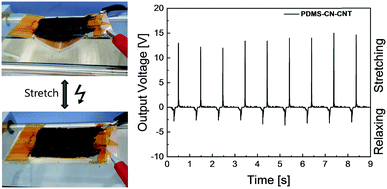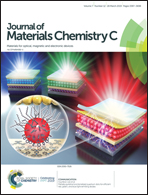Electrical energy generated by silicone elastomers filled with nanospring-carbon-nanotubes†
Abstract
Dielectric elastomer generators (DEGs) are flexible capacitors that convert mechanical into electrical energy. They rely on an external voltage source to charge the capacitor during each operation cycle. An alternative to this is an autonomous DEG which operates with an electret as integrated voltage source. To increase the amount of energy generated per cycle, elastomers with increased permittivity, low viscoelastic losses and high strain at break are of advantage. Here, we report the synthesis of elastic materials with increased permittivity by blending different silicone matrices with nanospring carbon-nanotubes (NS-CNTs) particles and their performance as dielectric in electret DEGs. The best material developed has a dielectric permittivity of ε′ = 4.6, a mechanical loss factor of 0.03 and a strain at break of 270%. The output voltage of the DEG constructed using this composite increases from 8.8 V to 14.5 V, when the strain increases from 33% to 66%, respectively. Additionally, the output voltage increases with the rise in permittivity, from 9.3 V for a regular polydimethylsiloxane elastomer (ε′ = 2.9) to 14.5 for the best composite (ε′ = 4.6).



 Please wait while we load your content...
Please wait while we load your content...